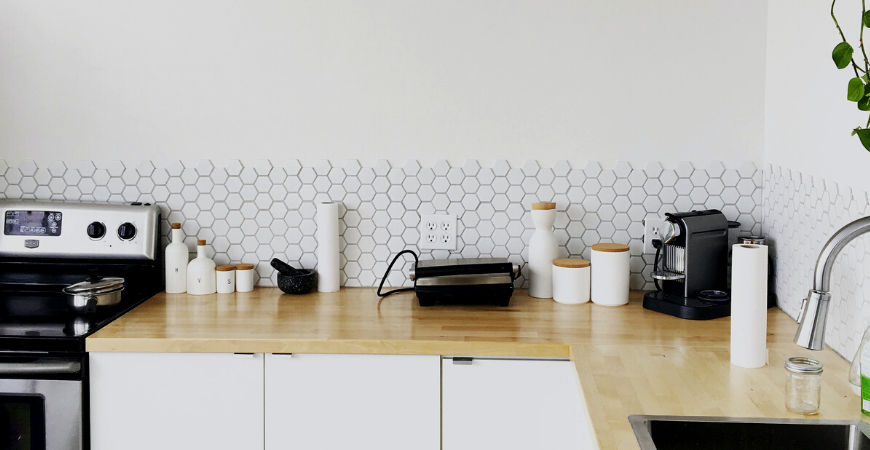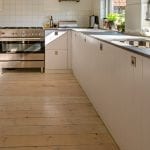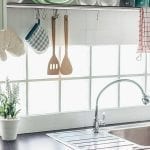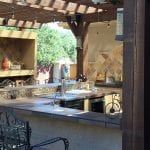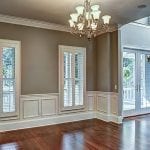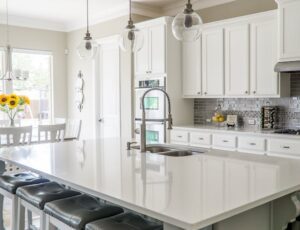
4 Budget-Friendly Kitchen Backsplash Ideas
Is your kitchen backsplash outdated or dull? Then, transform the look of your kitchen with a new backsplash! There are several backsplash ideas to update your above-the-countertop space.
From tiles to peel-and-sticks, read on to learn more about these kitchen backsplash ideas.
Subway Tile Backsplash
Subway tile was first used in New York City subway tunnels in the early 1900s. These tiles have a crisp, clean look making them one of the most popular and durable surfaces to add to kitchen backsplashes, showers, and other home surfaces.
Standard subway tiles are usually sold in three standard dimensions – 4” x 8”, 3” x 6”, and 2” x 4″.
Subway tiles are made of porcelain, ceramic, or glass and are rectangular shaped. Tiles can be set in a wide range of eye-catching patterns, including:
- Running bond offset (each tile joint aligns with the center of the tile that is above and below it)
- One-third offset
- One-fourth offset
- Straight set
- Vertical stack bond
- Vertical offset
- Herringbone
- Basketweave
Purchasing mosaic sheets of subway tile makes installation easier since each tile is pre-spaced. Thus, saving time from having to level and space the tiles.
However, it’s important to note that the smaller the tiles, the easier it will be to cut the tiles to fit around electrical wall outlets and under cabinets.
Skill Level Required To Create– Intermediate. You should be comfortable setting grout and operating a tile cutter or wet saw.
Cost – Subway tiles prices range from $27 to $34 per square foot, depending on quality, dimensions, and other factors.
What type of kitchen decor does subway tile compliment?
Subway tile pairs well with a modern, contemporary, and non-traditional kitchen design.
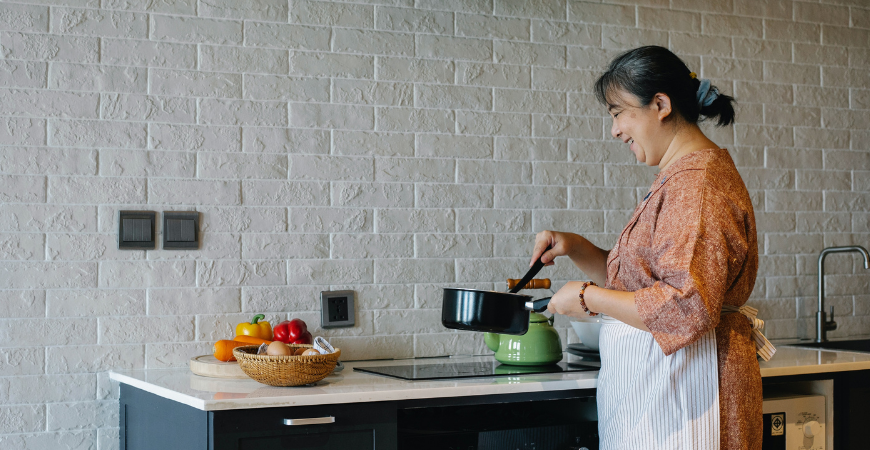
Faux Brick Backsplash
A faux brick backsplash is a budget-friendly and stylish option for your kitchen. Faux brick is often sold in 4 ft x 8 ft panels.
Measure your backsplash and create a template to cut the faux brick panels to size. Be sure to add a mark to cutouts for light switches and outlets.
Cut the panels to size and apply a quality construction adhesive to the back of a panel using a caulk gun. Position a panel on the kitchen wall. Reposition the panel if needed. Continue with the remaining panels.
Secure the panels with brad nails at the panel corners and long edges. To minimize the look of nail holes, drive nails into the panel’s mortar detail. Fill nail holes with a swipe of paintable caulk.
Add paintable caulk to finish corners and seams. Paint the brick with 2 coats of semi-gloss paint to match your kitchen décor and make the backsplash easier to clean.
A faux brick backsplash painted white will add a cozy cottage feel to any eating area.
Skill Level Required To Create– Beginner. If you can accurately measure, cut, caulk, and use a jigsaw, you’re good to go.
Cost – Faux brick panels cost approximately $9 to $15 per square foot. Material for a standard size backsplash (18-inch high by 16 ft. length) will cost less than $100.
What type of kitchen decor does faux brick compliment?
Faux brick pairs well with rustic, farmhouse, cottage, and vintage décor.
Peel-and-stick Tile Backsplash
Peel-and-stick backsplash materials are available in a wide array of designs that look similar to ceramic tile. Cut the material with scissors, peel off the backing, and carefully add it to the wall. A peel-and-stick backsplash is popular for its easy maintenance — just wipe it clean with a damp rag.
Peel-and-stick backsplashes are made from various materials, including water-resistant vinyl, hardened silica gel tiles, and thin mosaic tiles.
Before fitting peel-and-stick material around kitchen outlets and cabinets, it’s best to create a paper template first. Measure and cut butcher paper to fit the space before cutting your peel-and-stick panels. Don’t forget to measure the vertical space from the countertop’s edge to the cabinets’ underside.
Skill Level Required To Create – Beginner
If you can accurately measure and cut, peel-and-stick tile is simple to add to a kitchen wall.
Cost – Home repair expert, Bob Vila, says, “You can expect to pay $8 to $12 for a set of six vinyl peel-and-stick panels that will cover approximately 6 to 8 linear feet of wall. Three-dimensional tiles made from gel or glass run a bit more—as much as $10 per individual panel.”
What type of kitchen decor does peel-and-stick tile compliment?
Peel-and-stick tile is sold in various designs, patterns, and colors that will highlight any kitchen style. Choose a design and color that complements your kitchen’s look and décor.
Painted Backsplash
The biggest advantage of a painted backsplash is the savings. A quality oil-based or latex paint will provide a waterproof, durable surface that will last for years. Plus, cleaning a painted surface is easier than cleaning grout or metal tiling.
Before you paint, the current kitchen backsplash will need cleaning. Use TSP, water, and a nylon brush to remove grease and food stains. Use painter’s tape to mark off any areas (cabinets, countertops, sidewalls) to protect them from paint. Paint will refresh a tired tile backsplash as well.
Apply the first coat of paint. When the first coat is dry, check for any dust or dirt that may have become stuck in the paint. If so, use 220-grit sandpaper to sand any stuck debris to a smooth surface lightly. Apply a second coat of the color.
Skill Level Required To Create – Beginner. It’s as easy as cleaning and painting a wall.
Cost – Paint is usually the most budget-friendly backsplash upgrade. A gallon of high-quality paint will usually cover 10 linear feet – the price is $50 to $75. Save even more by catching a sale on the color you like.
What type of kitchen decor does a painted backsplash compliment?
A painted backsplash goes with any look or design. Choose and add a color that compliments your existing décor, appliances, and cabinets.
Tip: Keep your kitchen’s design and color scheme in mind when selecting the right backsplash material. The material’s color and design should coordinate with your kitchen’s current look. Additional backsplash materials include natural wood, stone, brick, and metal.


